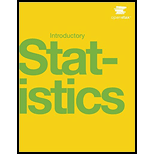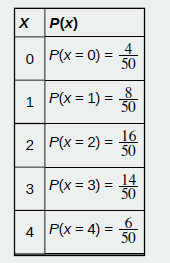
Concept explainers
A hospital researcher Is Interested In the number of times the average post-op patient will ring the nurse during a 12-hour shift. For a random sample of 50 patients, the following information was obtained. Let X = the number of times a patient rings the nurse during a 12-hour shift. For this exercise. x = 0, 1, 2, 3. 4, 5. P(x) = the


Why is this a discrete probability distribution (two reasons).
Answer to Problem 4.1TI
The two reasons this is a discrete probability distribution are:
- Each probability is between zero and one.
- The sum of probabilities is one.
Explanation of Solution
Given:
A hospital researcher is interested in the number of times the average post-op patient will ring the nurse during a 12-hour shift. For a random sample of 50 patients, the following information was obtained. Let X = the number of times a patient rings the nurse during a 12-hour shift.
Concept Used:
In statistic, discrete probability distribution is the one which describes the probability of happening of each value of discrete random variable. A discrete random variable is a random variable that has countable values such as the outcomes of dice related to rolling a dice once. A discrete probability distribution has two characteristics and these are:
- Each probability is between zero and one, inclusive.
- The sum of probabilities is one.
In the given problem, we are given the probability distribution of random variable the number of times a patient rings the nurse during a 12-hour shift. Now, let’s check these two characteristics.
We clearly see all the probabilities of the given random variable is between zero and one.
The sum of probabilities is:
Therefore, the two reasons to consider the given probability distribution are:
- Each probability of the given random experiment is between zero and one.
- The sum of probabilities of the given random experiment is one.
Want to see more full solutions like this?
Chapter 4 Solutions
Introductory Statistics
Additional Math Textbook Solutions
A First Course in Probability (10th Edition)
Elementary Statistics (13th Edition)
Introductory Statistics
Calculus: Early Transcendentals (2nd Edition)
Elementary Statistics: Picturing the World (7th Edition)
- A company found that the daily sales revenue of its flagship product follows a normal distribution with a mean of $4500 and a standard deviation of $450. The company defines a "high-sales day" that is, any day with sales exceeding $4800. please provide a step by step on how to get the answers in excel Q: What percentage of days can the company expect to have "high-sales days" or sales greater than $4800? Q: What is the sales revenue threshold for the bottom 10% of days? (please note that 10% refers to the probability/area under bell curve towards the lower tail of bell curve) Provide answers in the yellow cellsarrow_forwardFind the critical value for a left-tailed test using the F distribution with a 0.025, degrees of freedom in the numerator=12, and degrees of freedom in the denominator = 50. A portion of the table of critical values of the F-distribution is provided. Click the icon to view the partial table of critical values of the F-distribution. What is the critical value? (Round to two decimal places as needed.)arrow_forwardA retail store manager claims that the average daily sales of the store are $1,500. You aim to test whether the actual average daily sales differ significantly from this claimed value. You can provide your answer by inserting a text box and the answer must include: Null hypothesis, Alternative hypothesis, Show answer (output table/summary table), and Conclusion based on the P value. Showing the calculation is a must. If calculation is missing,so please provide a step by step on the answers Numerical answers in the yellow cellsarrow_forward

 Holt Mcdougal Larson Pre-algebra: Student Edition...AlgebraISBN:9780547587776Author:HOLT MCDOUGALPublisher:HOLT MCDOUGAL
Holt Mcdougal Larson Pre-algebra: Student Edition...AlgebraISBN:9780547587776Author:HOLT MCDOUGALPublisher:HOLT MCDOUGAL College AlgebraAlgebraISBN:9781305115545Author:James Stewart, Lothar Redlin, Saleem WatsonPublisher:Cengage Learning
College AlgebraAlgebraISBN:9781305115545Author:James Stewart, Lothar Redlin, Saleem WatsonPublisher:Cengage Learning- Algebra & Trigonometry with Analytic GeometryAlgebraISBN:9781133382119Author:SwokowskiPublisher:Cengage



